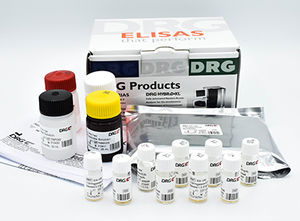
- Laboratory
- Laboratory medicine
- Thyroid disease test kit
- DRG Instruments GmbH
Thyroid disease test kit EIA4110anti-thyroglobulinclinicalserum
Add to favorites
Compare this product
Characteristics
- Applications
- for thyroid diseases
- Tested parameter
- anti-thyroglobulin
- Sample type
- clinical, serum, plasma
- Analysis mode
- immunoassay, enzyme immunoassay, colorimetric
- Result display time
15 min, 30 min, 60 min
- Sample volume
0.05 ml
(0.00169 US fl oz)
Description
The Quantitative Determination of Thyroglobulin (Tg) Autoantibodies in Human Serum or Plasma by a Microplate Enzyme Immunoassay, Colorimetric. Measurements of Tg autoantibodies may aid in the diagnosis of certain thyroid diseases such as Hashimoto’s and Grave’s as well as nontoxic goiter. Antibodies to thyroglobulin have been shown to be characteristically present from patients with thyroiditis and primary thyrotoxicosis.1,2 This has lead to the clinical measurement becoming a valuable tool in the diagnosis of thyroid dysfunction. Passive Hemaglutination (PHA) methods have been employed in the past for measurements of antibodies to Tg. PHA tests do not have the sensitivity of enzyme immunoassay and are limited by subjective interpretation. This procedure, with the enhanced sensitivity of EIA, permits the detectability of subclinical levels of antibodies to Tg. In addition, the results are quantitated by a spectrophotometer, which eliminates subjective interpretation. DRG’s microplate enzyme immunoassay methodology provides the technician with optimum sensitivity while requiring few technical manipulations. In this method, serum reference, diluted patient specimen, or control is first added to a microplate well. Biotinylated thyroglobulin (Tg) is added, and then the reactants are mixed. Reaction results between the autoantibodies to Tg and the biotinylated Tg to form an immune complex, which is deposited to the surface of streptavidin coated wells through the high affinity reaction of biotin and streptavidin.
Catalogs
No catalogs are available for this product.
See all of DRG Instruments GmbH‘s catalogsRelated Searches
- Assay kit
- Blood assay kit
- Serum assay kit
- Immunoassay assay kit
- Plasma assay kit
- Infectious disease detection kit
- Research reagent kit
- Molecular test kit
- Respiratory infection test kit
- Optical assay kit
- Clinical assay kit
- Reagent medium reagent kit
- ELISA assay kit
- Bacteria reagent kit
- Research assay kit
- IgG test kit
- Laboratory detection kit
- Cell assay kit
- Microbiology reagent kit
- Urine assay kit
*Prices are pre-tax. They exclude delivery charges and customs duties and do not include additional charges for installation or activation options. Prices are indicative only and may vary by country, with changes to the cost of raw materials and exchange rates.


